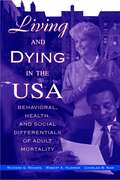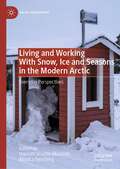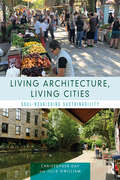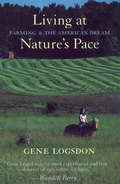- Table View
- List View
Liver, Lung and Heart Regeneration (Stem Cells in Clinical Applications)
by Phuc Van PhamThis invaluable resource discusses clinical applications with effects and side-effects of applications of stem cells in liver, lung and heart regeneration. All chapters are contributed by pre-eminent scientists in the field and covers such topics as cell therapy in the treatment of cirrhosis and other liver, heart and lung diseases, characteristics of hepatic progenitor cells, future directions of the discussed therapies and much more. Liver, Lung and Heart Regeneration and the other books in the Stem Cells in Clinical Applications series will be invaluable to scientists, researchers, advanced students and clinicians working in stem cells, regenerative medicine or tissue engineering.
Lives in Peril: Profit or Safety in the Global Maritime Industry?
by D. Walters N. BaileyLives in Peril demonstrates how and why seafarers are a vulnerable group of workers. It argues they are made so by the organisation and structure of their employment; the prioritisation of profit over safety by the actors that engage and control their labour; the limits of enforcement of the regulatory framework that is in place to protect them; and by their weakness as collective actors in relation to capital. The consequences of this vulnerability are seen in data on their occupationally-related morbidity and mortality - evidence that probably only represents a partial picture of the actual extent of the physical, mental and emotional harm resulting from work at sea. This volume's central argument is that this situation is likely to remain broadly unchanged as long as global maritime governance and regulation remains in thrall to the neo-liberal economic and political arguments that drive globalisation, and fails to enforce regulatory standards more robustly.
Livestock and Literature: Reimagining Postanimal Companion Species (Palgrave Studies in Animals and Literature)
by Liza B. BauerThis book explores the past and current traces that cows, pigs, chickens, and other animals used by humans have left in Anglophone literary fiction. In times of accelerated global warming, an acute pandemic, and breakthroughs in bioengineering practices, discussions on how to rethink the relationships to these animals have become as heated as perhaps never before. Livestock and Literature examines what literature has to contribute to these debates. In particular, it draws on counter-narratives to so-called livestock animals’ commodification in selected science- and speculative fiction (SF) works from the twenty-first century. These texts imagine ‘what if’ scenarios where “livestock” practice resistance, transform into biotechnologically modified, postanimal beings, or live in close companionship to humans. Via these three points of access, the study delineates the formal and thematic strategies SF authors apply to challenge anthropocentric and speciesist thought patterns. The aim is to shed light on how these alternative storyworlds expand readers’ understanding of the lives of farmed animals; seeking insight into how literature shapes human-animal relationships beyond the page.
Livestock and Wealth Creation: Improving The Husbandry Of Animals Kept By Resource-poor People In Developing Countries
by E OwenThis unique textbook is the product of a south/north, east/west collaboration, involving 105 contributors from 26 countries. It will be invaluable to all concerned with livestock keeping and poverty alleviation in developing countries, especially lecturers, students, NGOs, policy makers and those working with resource-poor livestock-keepers.
Livestock Biodiversity: Genetic Resources for the Farming of the Future
by Stephen J. HallLivestock biodiversity is integral to our culture, history, environment, economy and, most importantly, our future. Thousands of livestock breeds, from relatively small genetic pools, have evolved over time to suit particular environments and farming systems. This is both the result of natural processes and of human needs for specialized livestock – as our knowledge of genetics continues to increase we achieve a greater understanding of how this biodiversity evolved. This book offers a detailed and comprehensive overview of livestock biodiversity. It explores the history behind it, shows how livestock biodiversity can be utilized as animal genetic resources through breed development and by crossbreeding, examines the state of world livestock biodiversity today, and emphasizes the importance of conserving and developing the biodiversity of livestock. Special consideration is given to: • How livestock biodiversity arose and is maintained in relation to human society • How it can be used in sustainable agricultural development • How it can be conserved for the benefit of present and future generations • Why conservation biologists, as well as agriculturists, should be involved in its protection
Livestock Production and Climate Change
by Cadaba S PrasadIn a changing climate, livestock production is expected to exhibit dual roles of mitigation and adaptation in order to meet the challenge of food security. This book approaches the issues of livestock production and climate change through three sections: I. Livestock production, II. Climate change and, III. Enteric methane amelioration. Section I addresses issues of feed quality and availability, abiotic stress (heat and nutritional) and strategies for alleviation, livestock generated nitrogen and phosphorus pollution, and approaches for harnessing the complex gut microbial diversity. Section II discusses the effects of climate change on livestock diversity, farm animal reproduction, impact of meat production on climate change, and emphasising the role of indigenous livestock in climatic change to sustain production. Section III deals with the most recent approaches to amelioration of livestock methane such as breeding for low methane emissions, reductive acetogenesis, immunization/vaccine-based concepts and archaea phage therapy.
Living and Dying in the USA: Behavioral, Health, and Social Differentials of Adult Mortality
by Richard G. Rogers Robert A. Hummer Charles B. NamThe simplicity of using one data set in addressing the relationship of single variables to mortality distinguishes Living and Dying in the USA from other recent investigations of mortality. The authors use the recently released National Health Interview Survey and the National Death Index to make a definitive statement about demographics and mortality. By surveying demographic and sociocultural characteristics associated with mortality, socioeconomic effects, health-related conditions, and health status, they reveal connections among several factors related to mortality chances. Easily understood and cited, their study emphasizes the statistical methods underlying their revelations and invites readers to duplicate their results.Comprehensive coverage of US adult mortality differentialsBased on a new and innovative data setIncludes factors rarely examined in related mortality researchNot only documents mortality differentials, but explores explanations for themExtensive list of references associated with each chapterConsistent, straightforward methodology used throughout aids readers in both understanding the content and in comparing results from chapter to chapter
Living and Surviving in Harm's Way: A Psychological Treatment Handbook for Pre- and Post-Deployment of Military Personnel
by Sharon Morgillo Freeman Bret A. Moore Arthur FreemanIn Living and Surviving in Harm's Way, experts investigate the psychological impact of how warriors live and survive in combat duty. They address the combat preparation of servicemen and women, their support systems, and their interpersonal and intrapersonal experiences. The text maintains a focus on cognitive-behavioral interventions for treating various combat-related disorders, and addresses psychological health and adjustment after leaving the battlefield. The text is logically organized for easy reading and reference, and covers often overlooked topics such as preparation and training of service personnel, women in combat, and the indirect effects of combat stress on family. This book is written by clinicians who have in some ways experienced what they write about, and resonates with mental health professionals, servicemen and women, and their families. Any clinician hoping to treat a serviceman or woman effectively cannot afford to overlook this book.
Living and Surviving in Harm's Way: A Psychological Treatment Handbook for Pre- and Post-Deployment of Military Personnel
by Sharon Morgillo Freeman Bret A. Moore Arthur FreemanIn Living and Surviving in Harm's Way, experts investigate the psychological impact of how warriors live and survive in combat duty. They address the combat preparation of servicemen and women, their support systems, and their interpersonal and intrapersonal experiences. The text maintains a focus on cognitive-behavioral interventions for treating various combat-related disorders, and addresses psychological health and adjustment after leaving the battlefield. The text is logically organized for easy reading and reference, and covers often overlooked topics such as preparation and training of service personnel, women in combat, and the indirect effects of combat stress on family. This book is written by clinicians who have in some ways experienced what they write about, and resonates with mental health professionals, servicemen and women, and their families. Any clinician hoping to treat a serviceman or woman effectively cannot afford to overlook this book.
Living and Working With Snow, Ice and Seasons in the Modern Arctic: Everyday Perspectives (Arctic Encounters)
by Hannah Strauss-Mazzullo Monica TennbergThis book describes everyday practices of life in changing Arctic winter conditions. The authors explore the contemporary and situated outdoor practices in different work settings in Finnish Lapland and investigate how, for example, tourism, reindeer herding, cattle breeding and urban snow management adapt to the physically limiting or enabling features of cold temperatures, snow and ice. The book also highlights individual and societal adjustments to such harsh conditions and their seasonal changes in mobility, including winter cycling, use of snow mobiles and walking with studded shoes. The impact of a warming climate is a great concern for those utilising the enabling qualities of winter weather. The need, then, for continuous adaptation in everyday practices of work and mobility will increase in the future.
Living Architecture, Living Cities: Soul-Nourishing Sustainability
by Christopher Day Julie GwilliamIt’s widely accepted that our environment is in crisis. Less widely recognized is that three quarters of environmental damage is due to cities – the places where most of us live. As this powerful new book elucidates, global sustainability is therefore directly dependent on urban design. In Living Architecture, Living Cities Christopher Day and Julie Gwilliam move beyond the current emphasis on technological change. They argue that eco-technology allows us to continue broadly as before and only defers the impending disaster. In reality, most negative environmental impacts are due to how we live and the things we buy. Such personal choices often result from dissatisfaction with our surroundings. As perceived environment has a direct effect on attitudes and motivations, improving this can achieve more sustainable lifestyles more effectively than drastic building change – with its notorious performance-gap limitations. As it’s in places that our inner feelings and material reality interact, perceived environment is place-based. Ultimately, however, as the root cause of unsustainability is attitude, real change requires moving from the current focus on buildings and technology to an emphasis on the non-material. Featuring over 400 high quality illustrations, this is essential reading for anyone who believes in the value and power of good design. Christopher Day’s philosophy will continue to inspire students with an interest in sustainable architecture, urban planning and related fields.
Living Architecture, Living Cities: Soul-Nourishing Sustainability
by Christopher Day Julie GwilliamIt’s widely accepted that our environment is in crisis. Less widely recognized is that three quarters of environmental damage is due to cities – the places where most of us live. As this powerful new book elucidates, global sustainability is therefore directly dependent on urban design. In Living Architecture, Living Cities Christopher Day and Julie Gwilliam move beyond the current emphasis on technological change. They argue that eco-technology allows us to continue broadly as before and only defers the impending disaster. In reality, most negative environmental impacts are due to how we live and the things we buy. Such personal choices often result from dissatisfaction with our surroundings. As perceived environment has a direct effect on attitudes and motivations, improving this can achieve more sustainable lifestyles more effectively than drastic building change – with its notorious performance-gap limitations. As it’s in places that our inner feelings and material reality interact, perceived environment is place-based. Ultimately, however, as the root cause of unsustainability is attitude, real change requires moving from the current focus on buildings and technology to an emphasis on the non-material. Featuring over 400 high quality illustrations, this is essential reading for anyone who believes in the value and power of good design. Christopher Day’s philosophy will continue to inspire students with an interest in sustainable architecture, urban planning and related fields.
Living at Nature's Pace: Farming and the American Dream
by Wendell Berry Gene LogsdonFor decades, Logsdon and his family have run a viable family farm. Along the way, he has become a widely influential journalist and social critic, documenting in hundreds of essays for national and regional magazines the crisis in conventional agri-business and the boundless potential for new forms of farming that reconcile tradition with ecology. Logsdon reminds us that healthy and economical agriculture must work "at nature's pace," instead of trying to impose an industrial order on the natural world. Foreseeing a future with "more farmers, not fewer," he looks for workable models among the Amish, among his lifelong neighbors in Ohio, and among resourceful urban gardeners and a new generation of defiantly unorthodox organic growers creating an innovative farmers-market economy in every region of the country. Nature knows how to grow plants and raise animals; it is human beings who are in danger of losing this age-old expertise, substituting chemical additives and artificial technologies for the traditional virtues of fertility, artistry, and knowledge of natural processes. This new edition of Logsdon's important collection of essays and articles (first published by Pantheon in 1993) contains six new chapters taking stock of American farm life at this turn of the century.
Living Beyond Data: Toward Sustainable Value Creation (Intelligent Systems Reference Library #230)
by Yukio OhsawaThis book states that data users often suffer from the difficulty of acquiring knowledge for decision-making, and others are unsure how existing data are useful. The reader will be released from these dilemmas and enabled to act beyond patterns in past events by creating a process to interact with the data market and the dynamic real-world rich in new events. We present new approaches from the aspects of computation, communication, and their integration, to readers including analysts in sciences and businesses, systems managers, and learners desiring to design knowledge to learn. We show clues to explaining causalities in the target world of a black-box AI of which users may seek a predictive performance. For obtaining interpretable knowledge, we show the integration of model- and data-driven approaches, the analysis and perception of signals from data acquired in the cyber or the real word, and creative communication which connects demands to data by visualizing the data market as a place for innovations
Living Data: Making Sense of Health Bio-Sensing
by Maggie Mort Celia RobertsAs individuals increasingly seek ways of accessing, understanding and sharing data about their own bodies, this book offers a critique of the popular claim that ‘more information’ equates to ‘better health’. In a study that redefines the public, academic and policy related debates around health, bodies, information and data, the authors consider the ways in which the phenomenon of self-diagnosis has created alternative worlds of knowledge and practises which are often at odds with professional medical advice. With a focus on data that concerns significant life changes, this book explores the potential challenges related to people’s changing relationships with traditional health systems as access to, and control over data shifts.
Living Data: Making Sense of Health Bio-Sensing
by Maggie Mort Celia RobertsAs individuals increasingly seek ways of accessing, understanding and sharing data about their own bodies, this book offers a critique of the popular claim that ‘more information’ equates to ‘better health’. In a study that redefines the public, academic and policy related debates around health, bodies, information and data, the authors consider the ways in which the phenomenon of self-diagnosis has created alternative worlds of knowledge and practises which are often at odds with professional medical advice. With a focus on data that concerns significant life changes, this book explores the potential challenges related to people’s changing relationships with traditional health systems as access to, and control over data shifts.
Living Farms: Encouraging Sustainable Smallholders in Southern Africa
by Martin WhitesideDesigned as an accessible text on sustainable agriculture, this book contains information on community organization and participation, technologies for sustainability and the wider policy and service environment. The book looks at a variety of ways of encouraging sustainability through policy change and service provision, including: ways of improving financial services; ways of improving land security; and ways of improving training. The book is illustrated by a range of case studies and examples, and contains lists of contact addresses.
Living Farms: Encouraging Sustainable Smallholders in Southern Africa
by Martin WhitesideDesigned as an accessible text on sustainable agriculture, this book contains information on community organization and participation, technologies for sustainability and the wider policy and service environment. The book looks at a variety of ways of encouraging sustainability through policy change and service provision, including: ways of improving financial services; ways of improving land security; and ways of improving training. The book is illustrated by a range of case studies and examples, and contains lists of contact addresses.
Living in a Low-Carbon Society in 2050 (Energy, Climate and the Environment)
by Horace HerringCombining theory, case studies and speculative fiction, a range of contributors, from leading UK academics to pioneering renewable activists, create a compelling picture of the potential perks and pitfalls of a low carbon future.
Living Labs: Design and Assessment of Sustainable Living
by David V. Keyson Olivia Guerra-Santin Dan LocktonThis book presents the results of a multi-annual project with sustainable Living Labs in the United Kingdom, Sweden, Germany and the Netherlands.Living Labs – as initiated by the authors – have proved to be very promising research, design, co-creation and communication facilities for the development and implementation of sustainable innovations in the home. The book provides an inspiring introduction to both the methodology and business modelling for the Living Lab facilities. Understanding daily living at home is key to designing products and services that support households in their transition to more sustainable lifestyles. This book not only explores new ways of gaining insights into daily practices, but also discusses developing and testing design methods to create sustainable solutions for households. These new methods and tools are needed because those available are either ineffective or cause rebound-effects. Intended for researchers and designers with an interest in the transition to sustainable lifestyles, it also appeals to company leaders interested in new ways of developing sustainable innovations and offers suggestions for effectively applying Living Labs for sustainable urban development.
The Living Land: Agriculture, Food and Community Regeneration in the 21st Century
by Jules Pretty ObeThe Living Land sets out a new 'stakeholder' vision for rural regeneration in Europe. It integrates three themes: sustainable agriculture, localised food systems and rural community development. All three offer ways of rebuilding natural and social capital, and a large 'sustainability dividend' is waiting to be released from current practices - creating more jobs, more wealth and better lives from less.
The Living Land: Agriculture, Food and Community Regeneration in the 21st Century
by Jules Pretty ObeThe Living Land sets out a new 'stakeholder' vision for rural regeneration in Europe. It integrates three themes: sustainable agriculture, localised food systems and rural community development. All three offer ways of rebuilding natural and social capital, and a large 'sustainability dividend' is waiting to be released from current practices - creating more jobs, more wealth and better lives from less.
Living Off the Land in Space: Green Roads to the Cosmos
by C Bangs Greg Matloff Les JohnsonThis book presents a visionary concept for future development of space travel. It describes the enabling technology for future propulsion concepts and demonstrates how mankind will ‘live off the land in space’ in migration from Earth. For the next few millennia at least (barring breakthroughs), the human frontier will include the solar system and the nearest stars. Will it be better to settle the Moon, Mars, or a nearby asteroid and what environments can we expect to find in the vicinity of nearby stars? These are questions that need to be answered if mankind is to migrate into space.
Living on One Acre or Less: How to produce all the fruit, veg, meat, fish and eggs your family needs
by Sally MorganAn accessible and comprehensive guide, filled with everything you need to set up your own mini-farm and live more self-sufficiently.With the help of this handy book, you can grow all the fruit and vegetables your family needs, raise animals for meat and eggs, keep fish and bees, and even produce firewood on a plot of land of just one acre or less – all alongside your work and family life.Whether you have a garden, a paddock or perhaps the corner of a field, Sally Morgan guides you through various useful topics, including growing fruit and vegetables throughout the year, producing fish with aquaponics, and keeping livestock – poultry, pigs, sheep and goats. There is also helpful information on how to layout your plot, including fencing, poly tunnels or greenhouses, and tips on managing soil fertility. This updated edition also includes a chapter on coping with extreme weather conditions.Filled with practical advice, Living on One Acre or Less is essential reading for anyone who aspires to take control of their food supply or who wants to do more with the land they've got.



















